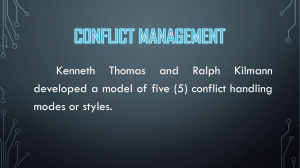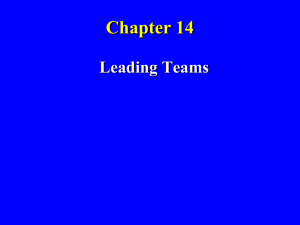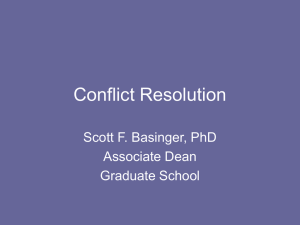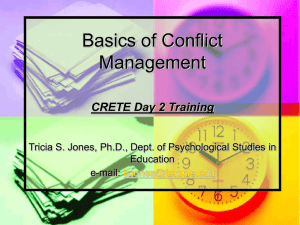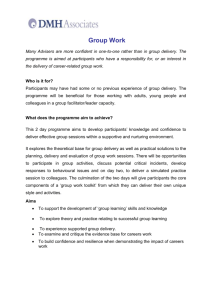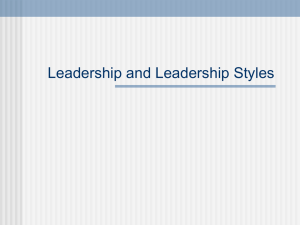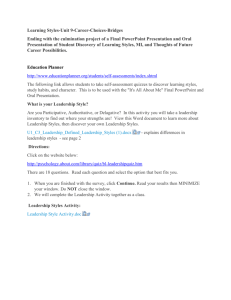Understanding Conflict Management Styles
advertisement
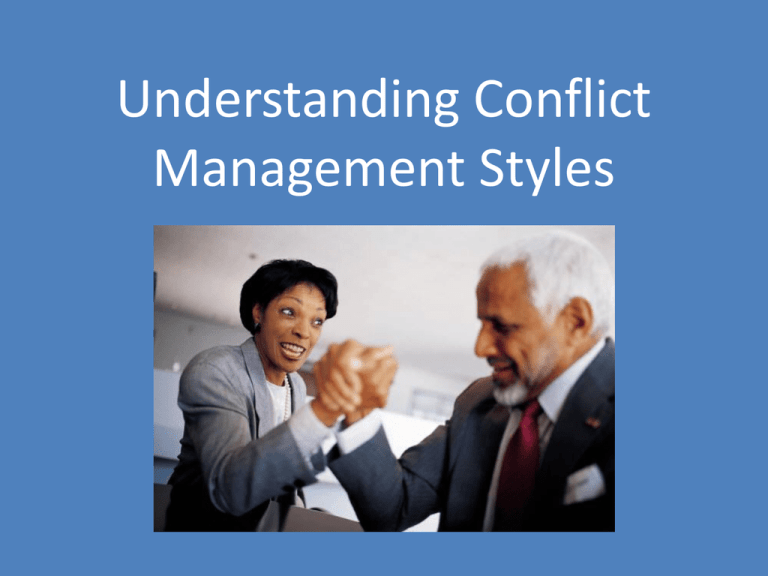
Understanding Conflict Management Styles What is a conflict management style and why do I need to know this? • Conflict Management Style: Form of behavior that a person practices in response to conflict with others • When living and interacting with others on campus, you need to know how to resolve issues in different situations. Conflict: Where does it come from? • Goals • Personality conflicts • Scarce resources • Styles • Values The Positive Side of Conflict • Conflict can teach you to make the most of each situation and use it as a learning opportunity or a leadership opportunity. • You can also use it as an opportunity to transform the situation into something better. Five Styles of Conflict Management You will experience some form of internal or external conflict while living with roommates at some point in your college career. Understanding how you handle conflict is important in helping you decide how to deal with stress and manage certain situations. Accommodating People who accommodate are unassertive and very cooperative. • Give in during a conflict • Acknowledge they made a mistake/decide it was no big deal • Put relationships first, ignore issues, and try to keep peace at any price • Effective when the other person or party has a better plan or solution Avoiding People who avoid conflict are generally unassertive and uncooperative. • Avoid the conflict entirely or delay their response instead of voicing concerns • Can create some space in an emotional environment • Not a good long-term strategy Collaborating Collaborators are both assertive and cooperative. • Assert own views while also listening to other views and welcoming differences • Seek a “win-win” outcome • Identify underlying concerns of a conflict • Create room for multiple ideas • Requires time and effort from both parties Competing People who approach conflict in a competitive way assert themselves and do not cooperate while pursuing their own concerns at another’s expense. • Takes on a “win-lose” approach where one person wins and one person loses • Does not rely on cooperation with the other party to reach outcome • May be appropriate for emergencies when time is important Compromising Compromisers are moderately assertive and moderately cooperative. • Try to find fast, mutually acceptable solutions to conflicts that partially satisfy both parties • Results in a “lose-lose” approach • Appropriate temporary solution • Considered an easy way out when you need more time to collaborate to find a better solution Which one is best? There is no BEST way to handle conflict. Each conflict is different and requires a different response. As a society, we teach: “Two heads are better than one.” (Collaborating) “Kill your enemies with kindness.” (Accommodating) “Split the difference.” (Compromising) “Leave well enough alone.” (Avoiding) “Might makes right.” (Competing) Conclusion • Different conflict management styles may be used when faced with different situations. • Knowing yourself and fully understanding each situation will help you understand the conflict management style needed. • Try a scenario-based approach to test the effectiveness of different approaches to specific situations. References • Thomas, K. W., & Kilmann, R. H. (2011). Five conflict management styles at a glance. Retrieved from http://sourcesofinsight.com/conflictmanagement-styles-at-a-glance/ and http://peacebuilding.caritas.org/index.php/Co nflict_Handling_Styles This work is licensed under a Creative Commons Attribution-NonCommercial 3.0 Unported License.
